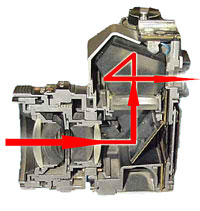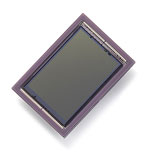Beginners Photography - How Light Works on a Digital Camera Sensor
This site is dedicated to helping everyone to take better photos, so what makes this section different?Well, the information here is written with the beginner in mind.
For example, you'll find many 'tooltips' among these pages, giving you, the reader extra information about specific photographic terminology.
The tooltips are underlined with a dotted line. Simply hover your mouse over the word(s) to get some extra information.
Understanding Light and Digital Sensors
By Amy Renfrey

When the shutter opens, it allows light to enter the camera. The lens reflects the image directly onto the film.
The reflected image tells the film how to record the light that came through the open shutter.
All of this is affected by the camera's settings, including the film speed (ISO), aperture (F-stop) and shutter speed as well.
Click for a more detailed explanation of the aperture .
Beginners Photography - Digital:
Digital photography has a great deal of the same language and also requires the use of the shutter, ISO and f-stop, as well as a special medium that is capable of recording the image in front of the camera accurately.The digital age means that no film stock is placed into the body of the camera, and instead a sensor receives and interprets the data.
The same effects are created by the camera settings, with the exception of the interpretation of true colors, and only the recording of the image takes place in a different manner.
Currently there are two available devices that are installed within the bodies of digital cameras as a means of recording images - CCD and CMOS - both of which are referred to as sensor.
The CCD means "charge-coupled device" and CMOS translates to "complementary metal oxide semiconductor" and both result in the same process within the camera's sensor unit.
Beginners Photography - What is a sensor?:
Basically the sensor device is covered by a grid of miniscule electrodes known as "photosites". Every single digital photograph is composed of the data translated by photosites, usually called pixels. Before the camera allows the
shutter to open it charges all of the photosites in the sensor. When
light strikes them they release some of their electrons and the
software within the camera then measures each of the areas of the
grid to record the locations of all of the electrons.
Before the camera allows the
shutter to open it charges all of the photosites in the sensor. When
light strikes them they release some of their electrons and the
software within the camera then measures each of the areas of the
grid to record the locations of all of the electrons.These are then converted through a special converter which ultimately translates to pixels and the photographic image that is stored on the camera's memory card.
Additionally, the sensor and photosites must be able to record or understand colors which is accomplished by a filter applied to the surface of the sensor, and which is capable of distinguishing a set range of colors within the recorded image.
Beginners Photography - Eliminating the mystery:
Understanding how the sensor of a digital camera works is not as important as understanding the effects achieved through changing the settings, but it does help to eliminate any of the mystery around taking photographs in this popular and rapidly advancing format.
|
This page was written by my good friend Amy Renfrey. For a steady supply of Amy's tips, have a look at her professionally tailored ebooks and ezines, written especially for beginner photographers. |
More beginners photography articles!
- Beginners Photography - The Basics
- Capturing Moving Water
- Shooting the Night Sky
- Editing Images in Photoshop
- Low Light and Indoor Photography
- How digital cameras work - understanding light and sensors
- Getting More Light on Indoor Photographs
- Learning digital photography
